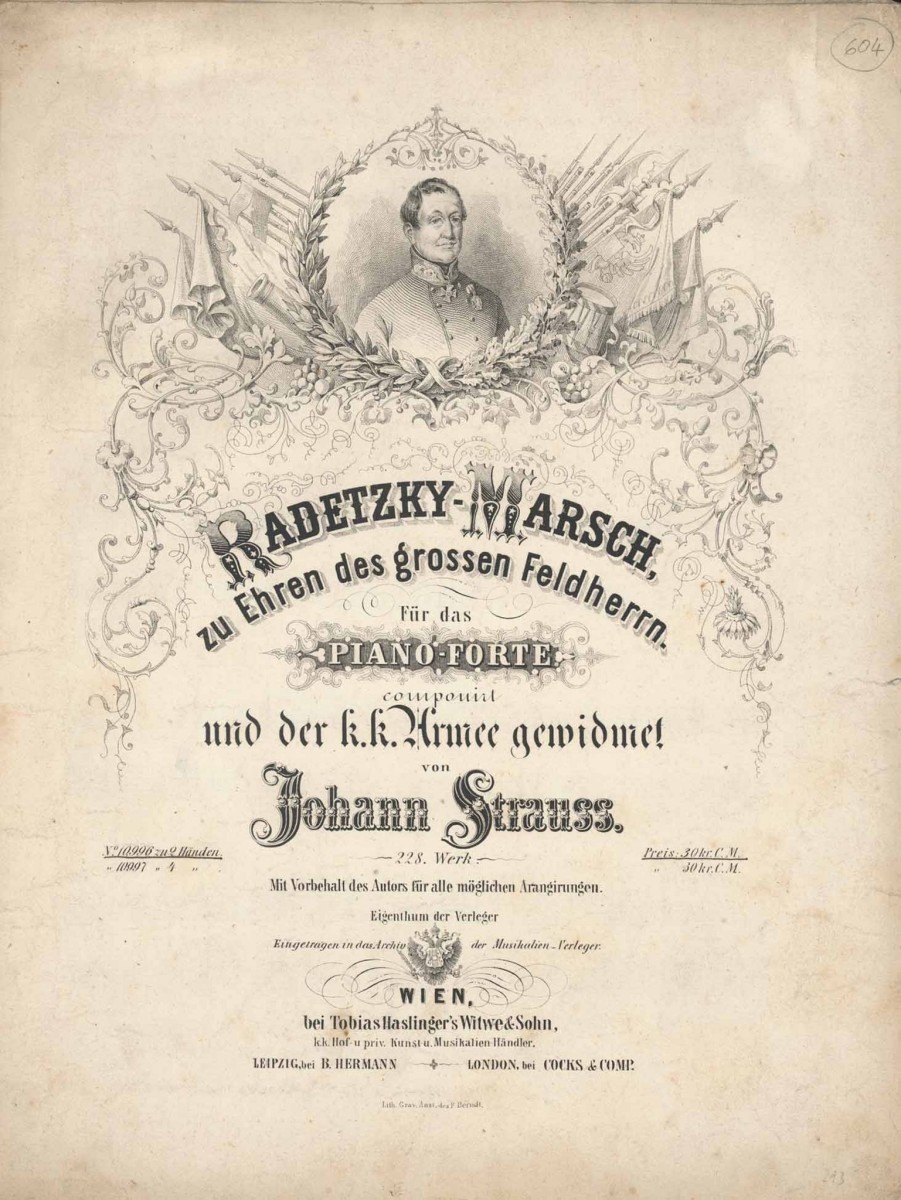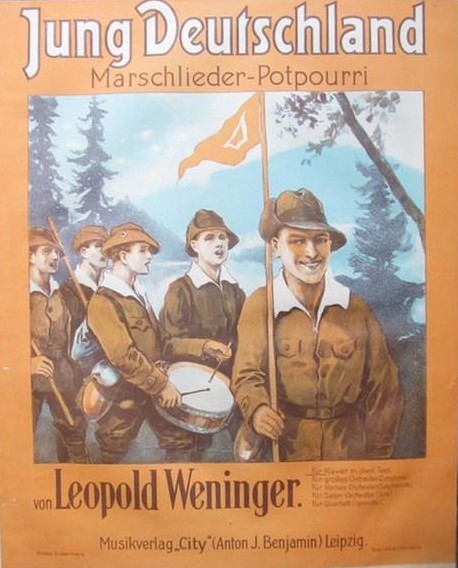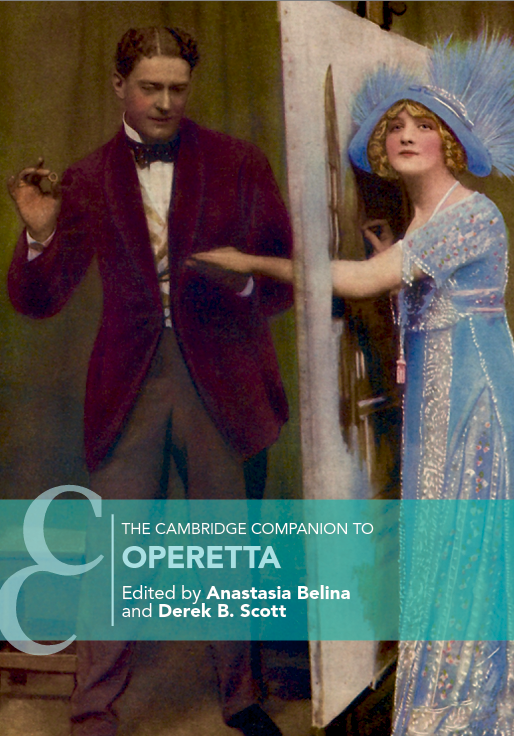Kevin Clarke
Operetta Research Center
31 December, 2019
The New Year’s concert from Vienna, with the Vienna Philharmonic, is a beloved tradition for many. It rarely has anything new to offer, and this year under the direction of conductor Andris Nelsons will not be an exception. But behind the facade of the eternal sameness there is one big change to look forward to, and it involves the most beloved “let’s all join in and clap” number of the entire concert: the famous Radetzky March at the end. In 2020 you’ll hear a new version!

A historic edition of the 1848 “Radetzky Marsch” by Johann Strauss senior.
The old version that has been performed for decades – in the name of “tradition” – is a version created by composer and glowing Nazi supporter Leopold Weninger (1879-1940). This was confirmed by the Vienna Philharmonic press office earlier this month and reported on by various German newspapers.
As a consequence the board of directors of the Vienna Philharmonic, represented by Daniel Froschauer, commissioned the music archivist of the orchestra to produce a new version. “This version will be used from now on,” Froschauer said. “On January 1st the audience in the golden hall may clap along to a version of the Radetzky March that was created as a joint venture with the Vienna Philharmonic and that is not contaminated by a ‘brown’ past.”

The 2020 New Years concert by the Vienna Philharmonic Orchestra will be released on Sony.
The arrangement by Leopold Weninger, that millions listened to via TV every year, was first introduced to the concert series in 1946 by legendary conductor Joseph Krips. Though Mr. Krips was certainly not a Nazi, Weninger was. He famously arranged marches for the “Sturmabteilung” (SA). He also turned the 1848 march by Johann Strauss senior into a very militant affair, which helped make the number popular in Nazi times. He added a special snare drum to make it all sound even more pointed, removed ornaments, and “fixed” the tune in the middle section. He also made the sound more “massive” and overwhelming, more in sync with the times. At least this is how various newspapers described the matter.

An edition of marching songs by Leopold Weninger called “Young Germany.”
We should not forget that Johann Strauss was part of the ideological Nazi campaign to redefine “operetta” as an “Aryan” genre and “save” it from its “decadent” Parisian roots. Johann Strauss junior was declared the “most German of composers,” the waltz was “the most Germanic of dances,” and 19th century “Viennese operetta” was the only true form of the genre everyone should aspire to, lifting it to classical heights instead of enjoying it as “banal” entertainment. That was left to the various new syncopated operettas, Maske in Blau, Hochzeitsnacht im Paradis, Clivia etc.
Countless books, recordings and movies cemented that ideology, among them Willi Forst’s Operette and Wiener Blut films (with the Vienna Philharmonic playing the soundtrack), and obviously the New Year’s concerts of the Vienna Philharmomic, originally introduced by Clemens Krauss. It continued after 1945 and transported many seemingly harmless ideas about Strauss, father and son, to a new era.

The Willi Forst film version of “Wiener Blut” from Nazi times emphasized the “nostalgic” element of the show and eliminated the mad-cap comedy.
There have been debates about the Nazi past of the Vienna Philharmonic’s New Year’s concert for years. But this year something is actually changing. While at the same time the idea of a “golden” 19th century Viennese operetta, as opposed to a somewhat inferior later “silver” era has just been revived by The Cambridge Companion to Operetta. It seems some things are hard to chuck out. The Vienna Philharmonic starting with the Radetzky March in 2020 might herald a new way of dealing with the past – even in territory so defined by traditions that few like to question. Claiming things have always been like this, thus barring change.

The cover of “The Cambridge Companion to Operetta.” (Photo: Cambridge University Press)
Well, things have not always been like many Strauss and operetta aficionados like to claim. And there was a Strauss and operetta tradition before 1933/38 that is worth remembering, now that we’re about to enter The New Twenties.
Why a new version of Radetzky March had to be commissioned, when the original version by Strauss sen. was discovered by Norbert Rubey in 1999 and performed by Nikolaus Harnoncourt at the 2001 New Year’s concert in Vienna, is another question. Probably a new version means new royalties, and who wouldn’t want those if they can be redirected? Also, the Harnoncourt version was played by the Vienna Phil pretty much “as always” so you need to listen very closely to notice any difference.
But obviously it’s always worth listening and looking closely when dealing with operetta history!
For more information on the concert and its program, click here. Various international TV stations will broadcast the concert live.

I had no idea that this wonderful composition was nazi. I listen for it for almost five decades. On the other hand, The International, the hymn of those who killed 100 millions of people, is interpreted on the streets of European Capitals. Now I understand where we go. I need to prepare my five children to the worst. Not Happy New Year, just Shame On You!
Rather over the top! JS2 was himself a quarter Jewish and proud of it. So Weininger made an arrangement of the tune? So what!
I suggest next we should disinfect the building of the Musikverein from roof to cellar because once upon a time Nazis have trod it, used it and sat in the seats too. Strong chemical substance ought to be used for that to be absolutely sure that the building is free from any Nazi influence. You can’t be strict enough (after 75 years)!
Awesome article, thanks for sharing this amazing fact unknown to most, Kevin, vielen Dank and congratulations!!!
So who cares? Music is music is music. Another useless article and,,, “Nazi” always makes a good headline…
As one of the editors of the Cambridge Companion to Operetta I’d like to put on record that I have never claimed the ‘Golden Age’ is superior to the ‘Silver Age’ in that book or elsewhere. I do, however, acknowledge the historical use of those terms.
Did they play the new arrangement?
For me it sounded same like every year.
The original version, that Harnoncourt conducted is really different from the well known.
1) no one knows Weninger’s 1914 arrangement since it has been strongly modified after Krips 1946; so you can knows this arrangement only if you have access to VPO archive or you have recordings 1928-1946; 2) what EXACTLY the differencies march 2020 vs. march 2019-2018-2017…??? (except ONE small thing that we heard in…1992!). In other words what are the effects of the efforts made by the distinguished new arrangers of VPO?? Please post a copy of the “special drum’s part” and of the “fixed middle part” (what means fixed middle parts??) ah okkk the newspaper said this…and we have to trust them. (PS: Strauss family belongs to the Juden). If Strauss was “the most Arian of the composers” why VPO did not refuse at all and forever to the NYC?? for money? I’d like to read Clarke’s (even technical) writing AFTER the 1st january 2020, not only before this date ;) 3) Harnoncout 2001 performed ONLY 85% the (so called) original version (I prefer to call it “the not lost archetyp” to avoid great and unacceptable misunderstandings originated by the word “original version”)! I can list the differencies (not small) 2001 vs. “original” restored by Rubey 1999 (but published only in 2004!). It were much better that VPO players may want to take much more cares in performing the Danube waltz that has been performed very bad. Who will now explain to the Juden Conductors Barenboim (and Maazel and Kleiber) the fact that their conducted and very enjoied a “nazi march” arranged in…1914????
Strauss the younger died in 1899. His music may have been used by the Nazis but he was most certainly dead by the time the Nazis came to power. Feel this article is misleading.
So what? Music is Music. what it has to do with some time some bad people have used it?
Thanks for finally talking about > De-Nazifying The "Radetzky March" At The
2020 Vienna New Year's Concert | Operetta Research Center < Loved it!